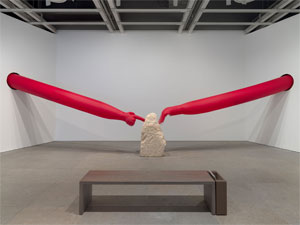5.19.25 — A Welcome Sign
If you have not dropped in at the Whitney in a while, now could be the time. You may never again receive such a warm welcome, but beware: you may come away wondering if its welcome is meant for you.
The lobby gallery is always free, already a welcome and welcoming gesture. Give the museum due credit. Its shows almost always focus on emerging artists, too, another gesture of outreach from the imperious art world. Now, though, it gestures in American Sign Language, an unprecedented sign of inclusion—and on a scale all but impossible to overlook. Two enormous red arms are wiggling their way to you. Christine Sun-Kim is something of a gatekeeper herself, as can happen in support of DEI, but you need not speak any one language to get the message, through July 6. 
Together, the two arms reach across the gallery and to each other, one inflating as the other collapses. One hand points toward its destination, a niche cut into stone, with a gesture familiar enough to anyone: pay attention, and not just to me. The other wiggles, its palm open and facing down. That gesture depends on ASL for its meaning, a plea for recognition. It could ask to initiate a true dialogue or for you to hold back, to give the deaf space and time.
Which one? Sun-Kim gets three floors of the Whitney, not all free, for “All Day All Night” and what comes to seem a gesture of certainty. She is joined on video by her partner, but as part of the same silent lecture. In works on paper and on the wall, she creates pretty much her own language and never stops talking. Why, one drawing asks, do her parents use ASL, too? Because they are way cooler than your parents, because they love her, and because they understand other visual sign systems as well—such as pie charts, Venn diagrams, and musical notation.
Well, maybe not the part about other systems, but she sure makes use of them, on her own terms. She borrows musical notes for their shape alone, stacked like chairs. Her circles overlap as in set theory, but their placement is meaningless. Her pie charts have any number of data points, but their width is meaningless, too. I borrowed two of her answers to the question about her parents and threw in a third just for fun. I cannot swear that it makes a difference.
To be sure, her many languages extend the welcome, and only a terrible pedant would expect a music or math lesson. Her adaptations show a welcome ingenuity and sense of humor, maybe even artistry. They address what could otherwise be a contradiction, a plea for ASL that in no way requires a knowledge of it from museum visitors. Besides, how nice that she is on speaking terms, so to speak, with her parents. I shall not tell you about mine. Still, the welcome and the humor vanish from the moment one starts reading.
The show’s entire premise has its limits. Sun-Kim is responding to Alexander Graham Bell (better known for the telephone), who campaigned against ASL as isolating and disabling. The deaf should learn lip reading and a full participation in the spoken word. Bell, though, died more than a hundred years ago, and the battle against him was long since won. Besides, he meant well, and the debate should down to the data, like a proper pie chart. It should come down, too, like halfway decent stand-up or performance art, to less of a tin ear.
Sun-Kim has a point, and (sigh) you better get it. Besides science, the case comes down to engaging the deaf on their own terms, as a community of the enabled and the living. And she rewards engagement with her witty notation and those enormous red hands. Charcoals outside the education department could be incipient constellations in an all-encompassing black sky. Get to the top floor, though, and she dominates the conversation with or without her parents. I want to be DEI and not a disabler (and I wrote about the point of political art or, for that matter, sound art just this spring), but art is not just about her, me, or you.
Read more, now in a feature-length article on this site.